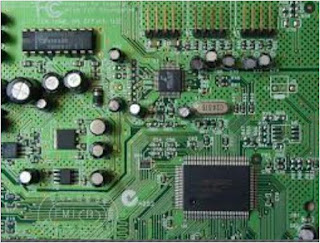Copperplate and Sheet Metal
Pure copper plate and tube have been applied in many parts and application because pure copper have good characteristic like have good electrical conductivity and resistance to corrode. For this character make copper also good as coating material for other sheet metal in order more stand to corrode because of base metal is protected by copper. So the corrosion reaction can’t attack the base metal.Copper plate is applied in several uses like in the below:
- Electrical Cable and printed circuit board
- Telecommunication network
- Architecture Planning for For building art
- Antimicrobial agent such as for fungicidal
- Gasket and seal as on car engine part
- Plumbing
- Industrial tanks and vats
- Electronic house hold such as tubing for Freezer agent
 |
| Printed Circuit Board |
Sulfuric acid is used as solution which has two hydrogen ions. Copper is a metal atom of which has two easily removable electrons. Copper sulfate (CuSO4) is the copper salt of sulfuric acid. In aqueous solution the copper ions, each with two positive charges due to loss of two electrons, separate them selves from the doubly charged negative sulfate ion SO42
If two copper plates, which may be called electrodes, are dipped into the solution of copper sulfate and a direct current applied to them, one plate will become negatively charged and the other positively charged. The negatively charged plate is called the cathode. When a copper ion touches the cathode, two electrons will transfer themselves from the cathode to the copper ion, and thus turn it back into metallic copper, simultaneously, at the positive electrode, the anode, a metallic atom on the electrode will slip away into the solution as a copper ion, leaving its two electrons behind. In this way the aqueous solution remains electrically neutral, but two electrons have been able to move down to connecting wire into the cathode, and another two up from the anode along its connecting wire. In other words a current (of electrons) flows in the metallic circuit, and a metallic atom has disappeared from the anode and another has appeared at the cathode.
Ions (whether anions or cations) do not move so freely in a solution as electrons do in a metal, so the rate at which that the current can pass from the solution to the cathode and deposit smooth copper is somewhat limited. The amount of current is obviously related to the area of the solution/metal interface, so it is called a current density. Under ordinary conditions it is limited in this case to about 30 A/ft2 of cathode area. This may be compared with a safe current of at least 1000 A/in2 of cross section in a metal. However, this rate of 30 A/ft2 of area corresponds to a growth of thickness of the coating of about 0.002 in/h (25 mm). This is fairly typical for most electroplating process, so that it will be seen that electroplating is essentially a rather slow method of metal coating.

No comments:
Post a Comment